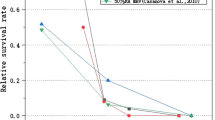Summary
The effect of relative humidity and temperature on the survival of bovine rotavirus in airborne particles was investigated. Bovine rotavirus was found to be stable at low and high relative humidity; infectivity was lost more rapidly at high temperature than at lower temperature.
Similar content being viewed by others
References
Benbough, J. E., Hood, A. M.: Viricidal activity of open air. J. Hyg. Camb.69, 619–626 (1971).
Bryden, A. S., Davies, H. A., Touless, M. E., Flewett, T. H.: Diagnosis of rotavirus infection by cell culture. J. Med. Microbiol.10, 121–125 (1977).
Darlow, H. M., Bale, W. R.: Infective hazards of water closets. Lanceti, 1196–1200 (1959).
Druett, H. A., May, K. R.: Unstable germicidal pollutant in rural air. Nature220, 385–396 (1968).
Druett, H. A.: A mobile form of the Henderson apparatus. J. Hyg. Camb.67, 437–448 (1969).
Gerba, C. P., Wallis, C., Melnick, J. L.: Microbiological hazards of household toilets: droplet production and the fate of residual organisms. Appl. Microbiol.30, 229–237 (1978).
Goldberg, L. J., Watkins, H. M. S., Boerke, E. E., Chatigny, M. A.: The use of a rotating drum for the study of aerosols over extended periods of time. Am J. Hyg.68, 85–93 (1958).
Hurst, C. J., Gerba, C. P.: Stability of simian rotavirus in fresh and estaurine water. Appl. Environ. Microbiol.39, 1–5 (1980).
Hurst, C. J., Gerba, C. P., Cech, I.: Effects of environmental variables and soil characteristics on virus survival in soil. Appl. Environ. Microbiol.40, 1067–1079 (1980).
Kraft, L. M.: Epozootic diarrhoea of infant mice and lethal intestinal infection of infant mice. In: Viruses of Laboratory Rodents (National Cancer Institute Monograph 20. Bethesda National Cancer Institute), 55–61. 1966.
May, K. R.: The Collison nebulizer: description, performance and application. Aerosol Science4, 235–242 (1972).
May, K. R.: Multistage liquid impinger. Bact. Rev.30, 559–570 (1966).
May, K. R., Harper, G. J.: The efficiency of various liquid impinger samplers in bacterial aerosols. Br. J. Irdns. Med.14, 85–93 (1958).
Steinmann, J.: Detection of rotavirus in sewage. Appl. Environ. Microbiol.41, 1043–1045 (1981).
Teltsch, B., Katzenelson, E.: Airborne enteric bacteria and viruses from spray irrigation with waste water. Appl. Environ. Microbiol.35, 290–296 (1978).
Author information
Authors and Affiliations
Additional information
With 2 Figures
Rights and permissions
About this article
Cite this article
Moe, K., Harper, G.J. The effect of relative humidity and temperature on the survival of bovine rotavirus in aerosol. Archives of Virology 76, 211–216 (1983). https://doi.org/10.1007/BF01311105
Received:
Accepted:
Issue Date:
DOI: https://doi.org/10.1007/BF01311105




